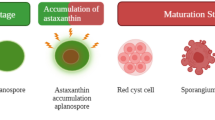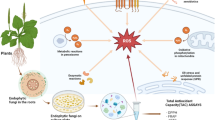Abstract
To identify the substrates and enzymes related to resveratrol biosynthesis in Alternaria sp. MG1, different substrates were used to produce resveratrol, and their influence on resveratrol production was analyzed using high performance liquid chromatography (HPLC). Formation of resveratrol and related intermediates was identified using mass spectrum. During the biotransformation, activities of related enzymes, including phenylalanine ammonia-lyase (PAL), trans-cinnamate 4-hydroxylase (C4H), and 4-coumarate-CoA ligase (4CL), were analyzed and tracked. The reaction system contained 100 mL 0.2 mol/L phosphate buffer (pH 6.5), 120 g/L Alternaria sp. MG1 cells, 0.1 g/L MgSO4, and 0.2 g/L CaSO4 and different substrates according to the experimental design. The biotransformation was carried out for 21 h at 28 °C and 120 rpm. Resveratrol formation was identified when phenylalanine, tyrosine, cinnamic acid, and p-coumaric acid were separately used as the only substrate. Accumulation of cinnamic acid, p-coumaric acid, and resveratrol and the activities of PAL, C4H, and 4CL were identified and changed in different trends during transformation with phenylalanine as the only substrate. The addition of carbohydrates and the increase of phenylalanine concentration promoted resveratrol production and yielded the highest value (4.57 μg/L) when 2 g/L glucose, 1 g/L cyclodextrin, and phenylalanine (4.7 mmol/L) were used simultaneously.








Similar content being viewed by others
References
Altekar W, Rangaswamy V (1990) Indication of a modified EMP pathway for fructose breakdown in a halophilic archaebacterium. FEMS Microbiol Lett 69:139–143
Baur JA, Sinclair DA (2006) Therapeutic potential of resveratrol: the in vivo evidence. Nat Rev Drug Discov 5:493–506
Beaudoin-Eagan LD, Thorpe TA (1985) Tyrosine and phenylalanine ammonia lyase activities during shoot initiation in tobacco callus cultures. Plant Physiol 78:438–441
Becker JVW, Armstrong GO, Merwe MJ, Lambrechts MG, Vivier MA, Pretorius IS (2003) Metabolic engineering of Saccharomyces cerevisiae for the synthesis of the wine-related antioxidant resveratrol. FEMS Yeast Res 4:79–85
Beekwilder J, Wolswinkel R, Jonker H, Hall R, de Vos CH, Bovy A (2006) Production of resveratrol in recombinant microorganisms. Appl Environ Microb 72:5670–5672
Beihadj A, Telef N, Saigne C, Cluzet S, Barrieu F, Hamdi S, Merillon JM (2008) Effect of methyl jasmonate in combination with carbohydrates on gene expression of PR proteins, stilbene and anthocyanin accumulation in grapevine cell cultures. Plant Physiol Biochim 46:493–499
Berner M, Krug D, Bihlmaier C, Vente A, Muller R, Bechthold A (2006) Genes and enzymes involved in caffeic acid biosynthesis in the actinomycete Saccharothrix espanaensis. J Bacteriol 188:2666–2673
Bradamante S, Barenghi L, Villa A (2004) Cardiovascular protective effects of resveratrol. Cardiovasc Drug Rev 22:169–188
Bru R, Selles S, Casado-Vela J, Belchi-Navarro S, Pedren˜o MA, (2006) Modified cyclodextrins are chemically defined glucan inducers of defense responses in grapevine cell cultures. J Agric Food Chem 54:65–71
Charmila C, Ratnasooriya HP, Rupasinghe V (2012) Extraction of phenolic compounds from grapes and their pomace using β-cyclodextrin. Food Chem 134:625–631
Dai R, Ge H, Howard S, Qiu W (2012) Transcriptional expression of stilbene synthase genes are regulated developmentally and differentially in response to powdery mildew in Norton and Cabernet Sauvignon grapevine. Plant Sci 197:70–76
Donnez D, Jeandet P, Clément C, Courot E (2009) Bioproduction of resveratrol and stilbene derivatives by plant cells and microorganisms. Trends Biotechnol 27:706–713
Donnez D, Kim KH, Antoine S, Conreux A, de Luca V, Jeandet P, Clement C, Courot E (2011) Bioproduction of resveratrol and viniferins by an elicited grapevine cell culture in a 2 L stirred bioreactor. Process Biochem 46:1056–1062
Dudley J, Das S, Mukherjee S, Das DK (2009) Resveratrol, a unique phytoalexin present in red wine, delivers either survival signal or death signal to the ischemic myocardium depending on dose. J Nutr Biochem 20:443–452
Fernandes P, Cruz A, Angelova B, Pinheiro HM, Cabral JMS (2003) Microbial conversion of steroid compounds: recent developments. Enzym Microb Technol 32:688–705
Ferri M, Righetti L, Tassoni A (2011) Increasing sucrose concentrations promote phenylpropanoid biosynthesis in grapevine cell cultures. J Plant Physiol 168:189–195
Gresele P, Cerletti C, Guglielmini G, Pignatelli P, de Gaetano G, Violi F (2011) Effects of resveratrol and other wine polyphenols on vascular function: an update. J Nutr Biochem 22:201–211
Horinouchi S (2009) Combinatorial biosynthesis of plant medicinal polyketides by microorganisms. Curr Opin Chem Biol 13:197–204
Howitz KT, Bitterman KJ, Cohen HY, Lamming DW, Lavu S, Wood JG, Zipkin RE, Chung P, Kisielewski A, Zhang LL, Scherer B, Sinclair DA (2003) Small molecule activators of sirtuins extend Saccharomyces cerevisiae lifespan. Nature 425:191–196
Jeandet P, Delaunois B, Aziz A, Donnez D, Vasserot Y, Cordelier S, Courot E (2012) Metabolic Engineering of yeast and plants for the production of the biologically active hydroxystilbene, resveratrol. J Biomed Biotechnol 2012:14. doi:10.1155/2012/579089
Kaneko M, Ohnishi Y, Horinouchi S (2003) Cinnamate: coenzyme A ligase from the filamentous bacterium Streptomyces coelicolor A 3(2). J Bacteriol 185:20–27
Kiselev KV, Tyunin AP, Zhuravlev YN (2013) Involvement of DNA methylation in the regulation of STS10 gene expression in Vitis amurensis. Planta 237:933–941
Knobloch KH, Hahlbrock K (1977) 4-Coumarate: CoA ligase from cell suspension culture of Petroselinum hortense Hoffm: partial purification, substrate specificity, and further properties. Arch Biochem Biophys 184:237–248
Kondan A, Kuroda H, Sakai F (2001) Simultaneous expression of stilbene synthase genes in Japanese red pine (Pinus densiflora). J Wood Sci 47:58–62
Kumar SN, Siji JV, Rajasekharan KN, Nambisan B, Mohandas C (2012) Bioactive stilbenes from a Bacillus sp. N strain associated with a novel rhabditid entomopathogenic nematode. Lett Appl Microbiol 54:410–417
Lamb CJ, Rubery PH (1975) A spectrophotometric assay for trans-cinnamic acid 4-hydroxylase activity. Anal Biochem 68:554–561
Lee SM, Yang H, Tartar DM, Gao B, Luo X, Ye SQ, Zaghouani H, Fang D (2011) Prevention and treatment of diabetes with resveratrol in a non-obese mouse model of type 1 diabetes. Diabetologia 54:1136–1146
Lijavetzky D, Almagro L, Belchi-Navarro S, Martínez-Zapater JM, Bru R, Pedreno MA (2008) Synergistic effect of methyljasmonate and cyclodextrin on stilbene biosynthesis pathway gene expression and resveratrol production in Monastrell grapevine cell cultures. BMC Res Notes 1:132
Lim CG, Fowler ZL, Hueller T, Schaffer S, Koffas MAG (2011) High-yield resveratrol production in engineered Escherichia coli. Appl Environ Microb 77:3451–3460
Liu ZY, Zhuang CX, Sheng SJ, Shao L, Zhao W, Zhao SJ (2011) Overexpression of a resveratrol synthase gene (PcRS) from Polygonum cuspidatum in transgenic Arabidopsis caused the accumulation of trans-piceid with antifungal activity. Plant Cell Rep 30:2027–2036
Lou JF, Fu LY, Peng YL, Zhou L (2013) Metabolites from Alternaria fungi and their bioactivities. Molecules 18:5891–5935
Lucas-Abellan C, Fortea I, Lopez-Nicolas JM, Nunez-Delicado E (2007) Cyclodextrins as resveratrol carrier system. Food Chem 104:39–44
Marienhagen J, Bott M (2013) Metabolic engineering of microorganisms for the synthesis of plant natural products. J Biotechnol 163:166–178
Murata K, Tani K, Kato J, Chibate I (1981) Glycolytic pathway as an ATP generation system and its application to the production of glutathione and NADH. Enzyme Microb Technol 3:233–242
Park SR, Yoon JA, Paik JH, Park JW, Jung WS, Ban YH, Kim EJ, Yoo YJ, Han AR, Yoon YJ (2009) Engineering of plant-specific phenylpropanoids biosynthesis in Streptomyces venezuelae. J Biotechnol 141:181–188
Pavlovic R, Cannizzo FT, Panseri S, Biolatti B, Trutic N, Biondi PA, Chiesa L (2013) Tetrahydro-metabolites of cortisol and cortisone in bovine urine evaluated by HPLC-ESI-mass spectrometry. J Steroid Biochem 135:30–35
Ro DK, Douglas CJ (2004) Reconstitution of the entry point of plant phenylpropanoid metabolism in yeast (Saccharomyces cerevisiae): implications for control of metabolic flux into the phenylpropanoid pathway. J Biol Chem 279:2600–2607
Ronimus RS, Morgan HW (2003) Distribution and phylogenies of enzymes of the Embden–Meyerhof–Parnas pathway from archaea and hyperthermophilic bacteria support a gluconeogenic origin of metabolism. Archaea 1:199–221
Shi JL, Zeng Q, Liu YL, Pan ZL (2012) Alternaria sp. MG1, a resveratrol-producing fungus: isolation, identification, and optimal cultivation conditions for resveratrol production. Appl Microbiol Biotechnol 95:369–379
Shin SY, Han NS, Park YC, Kim MD, Seo JH (2011) Production of resveratrol from p-coumaric acid in recombinant Saccharomyces cerevisiae expressing 4-coumarate: coenzyme A ligase and stilbene synthase genes. Enzym Microb Technol 48:48–53
Shumakova OA, Manyakhin AY, Kiselev KV (2011) Resveratrol content and expression of phenylalanine ammonia-lyase and stilbene synthase genes in cell cultures of Vitis amurensis treated with coumaric acid. Appl Biochem Biotechnol 165:1427–1436
Sun H, Lapidus A, Nolan M, Lucas S, Del Rio TG, Tice H, Cheng JF, Tapia R, Han C, Goodwin L, Pitluck S, Pagani L, Lvanova N, Mavromatis K, Mikhailova N, Pati A, Chen A, Palaniappan K, Land M, Hauser L, Chang YJ, Jeffries CD, Djao ODN, Rohde M, Sikorski J, Goker M, Woyke T, Bristow J, Eisen JA, Markowitz V, Hugenholtz P, Kyrpides NC, Klenk HP (2010) Complete genome sequence of Nocardiopsis dassonvillei type strain (IMRU 509). Stand Genomic Sci 3:325–336
Vannelli T, Wei QW, Sweigard J, Gatenby AA, Sariaslani FS (2007a) Production of p-hydroxycinnamic acid from glucose in Saccharomyces cerevisiae and Escherichia coli by expression of heterologous genes from plants and fungi. Metab Eng 9:142–151
Vannelli T, Xue ZX, Breinig S, Qi WW, Sariaslani FS (2007b) Functional expression in Escherichia coli of the tyrosine-inducible tyrosine ammonia-lyase enzyme from yeast Trichosporon cutaneum for production of p-hydroxycinnamic acid. Enzym Microb Technol 41:413–422
Wang YC, Yu O (2012) Synthetic scaffolds increased resveratrol biosynthesis in engineered yeast cells. J Biotechnol 157:258–260
Watts KT, Lee PC, Schmidt-Dannert C (2006) Biosynthesis of plant-specific stilbene polyketides in metabolically engineered Escherichia coli. BMC Biotechnol 6:22
Wu L, Wang X, Xu W, Farzaneh F, Xu R (2009) The structure and pharmacological functions of coumarins and their derivatives. Curr Med Chem 16:4236–4260
Wu ZJ, Wang JH, Fang DM, Zhang GL (2013) Analysis of iridoid glucosides from Paederia scandens using HPLC-ESI-MS/MS. J Chromatogr B 923–924:54–64
Xu QY, Ma L, Xie XX, Che N, Wang J (2012) Impacts of sodium citrate on metabolic flux distributions of L-valine fermentation. Adv Mater Res 343–344:643–648
Xue Z, McCluskey M, Cantera K, Ben-Bassat A, Sariaslani FS, Huang LX (2007) Improved production of p-hydroxycinnamic acid from tyrosine using a novel thermostable phenylalanine/tyrosine ammonia lyase enzyme. Enzym Microb Technol 42(58):64
Yimga MT, Leatham MP, Allen JH, Laux DC, Conway T, Cohen PS (2006) Role of gluconeogenesis and the tricarboxylic acid cycle in the virulence of Salmonella enterica serovar typhimurium in BALB/c mice. Infect Immun 74:1130–1140
Zhang JH, Shi JL, Liu YL (2013) Bioconversion of resveratrol using resting cells of non genetically modified Alternaria sp. Biotechnol Appl Biochem 60:236–243
Acknowledgments
This work was supported by the Agriculture Department of China through Project no. CARS-30 and 201003021.
Author information
Authors and Affiliations
Corresponding author
Electronic supplementary material
Below is the link to the electronic supplementary material.
ESM 1
(PDF 820 kb)
Rights and permissions
About this article
Cite this article
Zhang, J., Shi, J. & Liu, Y. Substrates and enzyme activities related to biotransformation of resveratrol from phenylalanine by Alternaria sp. MG1. Appl Microbiol Biotechnol 97, 9941–9954 (2013). https://doi.org/10.1007/s00253-013-5212-3
Received:
Revised:
Accepted:
Published:
Issue Date:
DOI: https://doi.org/10.1007/s00253-013-5212-3




